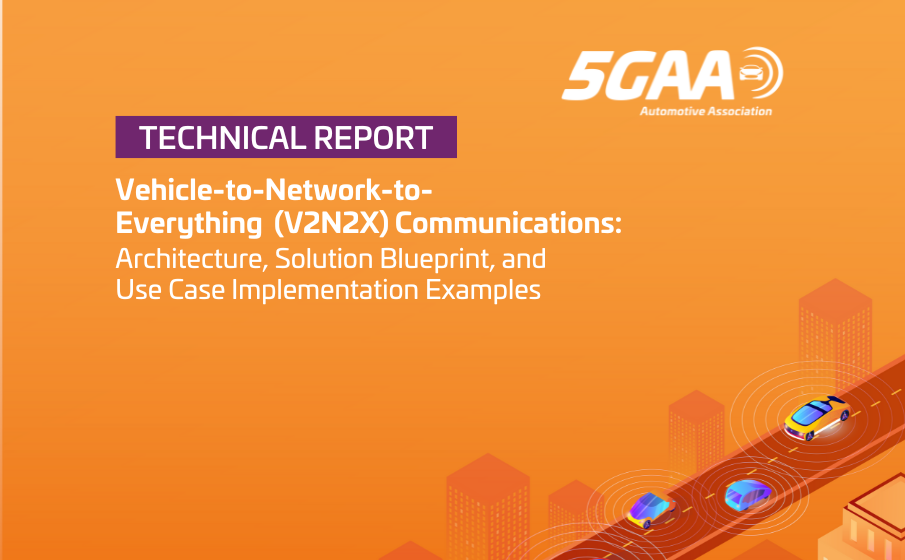
Vehicle-to-Network-to-Everything (V2N2X) Communications: Architecture, Solution Blueprint, and Use Case Implementation Examples
This technical report builds on the 5GAA white paper “Road traffic operation in a digital age” and guides stakeholders on implementing various vehicle-to-everything (V2X) applications using cellular networks and information sharing structures between backend systems.
It presents an application-level reference blueprint architecture and introduces an “information sharing domain” to enable scalable digital data exchange among stakeholders such as vehicle manufacturers, service providers, and infrastructure operators. The report details how to implement V2X applications that enhance safety and mobility, with examples including traffic event and signal information sharing, emergency vehicle approaching alerts, automated valet parking, and vulnerable road user protection. It also explains different implementation options for these applications within vehicles, distinguishing between OEM-controlled, OEM-supported, and OEM-independent apps.
Additionally, it describes proven solutions and references initial deployments like C-Roads and Talking Traffic, highlighting their effectiveness in accelerating V2X service adoption. Ecosystem stakeholders are encouraged to use this document as a guide for deploying V2X services using cellular networks and information sharing, with the potential to address more demanding use cases through enhanced cellular network capabilities.
Read the full report here.
For more information, find the complementary technical report “Business Perspectives on Vehicle-to-
Network-to-Everything (V2N2X) Deployments.”
A 5GAA online session on the V2N2X topic and reports took place on 18 June 2024. The recording of the online session can be accessed here. The slides of the presentation can be accessed here.
The paper was originally published in May 2024. The current downloadable version is the updated edition, released on 3 June 2025. 5GAA remains committed to keeping all its publications accurate and up to date.

Study on integrated sensing and communication (ISAC) for C-V2X application
The Work Item “Study on Integrated Sensing and Communication for C-V2X Application” aims to discuss the integration of sensing and communication systems into one system from an automotive perspective. The Work Item aims to identify key features relevant for the realization of the selected automotive use cases.
The Technical Report outlines the objectives and goals of the work item, implementation descriptions of automotive use cases with ISAC and key technology trends to facilitate the application of ISAC in C-V2X scenarios. The objectives of the work item are thus:
Analysis of ISAC use cases and ISAC concept development
- Identify applicable ISAC use cases for connected mobility from 5GAA, academia, standards organizations (SDO) such as 3GPP SA1, etc.
- Define criteria/rationales to select a subset of use cases.
- Update use cases to identify the value and impact of ISAC technologies.
- Derive sensing requirements for selected use cases.
- Establish quantitative general metrics to evaluate and measure the performance of ISAC solutions to guide research and standardization.
- Describe an ISAC concept based on existing technologies in the automotive sector/field.
Study possible ISAC technology trends
- Do state-of-the-art study of the evolution and technology trends of new ISAC features in research and SDOs (e.g. 3GPP, ETSI) and analyze the potential impact on both communication and sensing systems from the automotive
perspective. - Analyze ISAC technology features relevant for the identified automotive use cases
Download the Technical Report here.
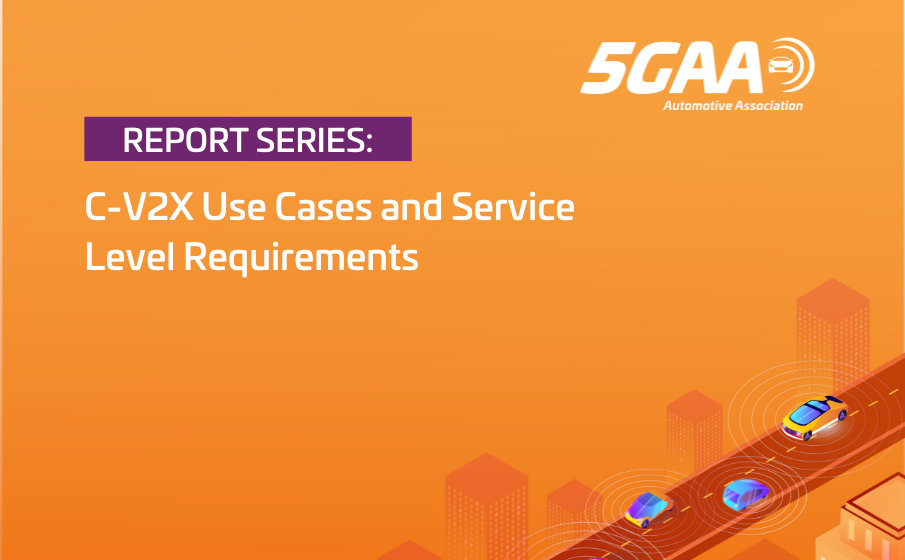
C-V2X Use Cases and Service Level Requirements (Vols. I, II and III)
This updated document series from the 5G Automotive Association (5GAA) provides a comprehensive framework for defining and analysing C-V2X use cases and their associated Service Level Requirements (SLRs). It builds upon previous work, refining methodologies for describing use case scenarios, considering factors like road environments and involved actors.
Published in three volumes, each of them includes a curated set of C-V2X use cases, respectively detailed with specific SLRs. These use cases serve as a valuable resource for 5GAA work groups, guiding the development of C-V2X solutions, informing standardisation efforts, and supporting the creation of robust business cases for deployment.
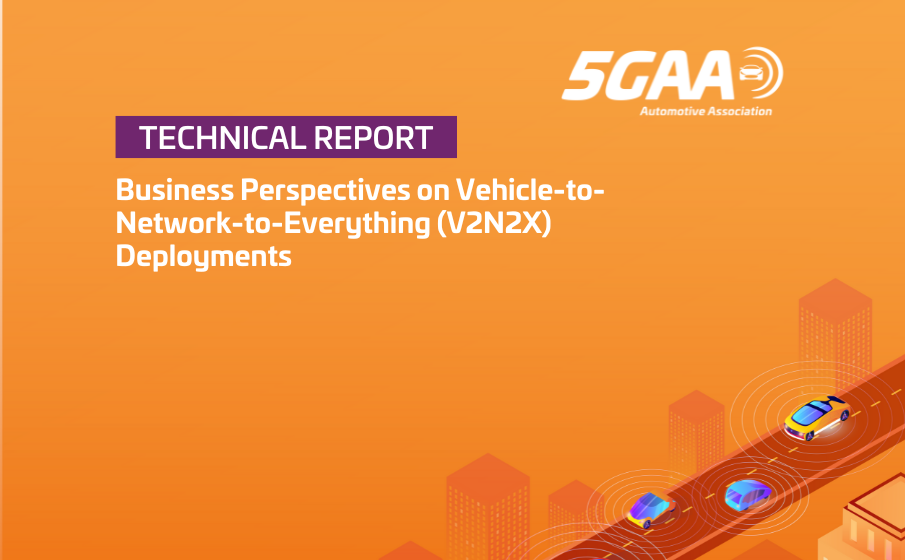
Business Perspectives on Vehicle-to-Network-to-Everything (V2N2X) Deployments
Cellular networks are increasingly enabling data exchange within the transport ecosystem. This document provides a business perspective on the Vehicle-to-Network-to-Everything (V2N2X) market, covering market value, stakeholder needs, market growth drivers, and business models observed in various deployments. It complements the high-level V2N2X architecture described in the 5GAA white paper “Road traffic operation in a digital age” and the technical report “Vehicle-to-Network-to-Everything (V2N2X) Communications; Architecture, Solution Blueprint, and Use Case Implementation Examples.”
While the full set of V2N2X features and foundational technologies is still evolving, current implementations demonstrate that the architecture can be deployed using existing networks. Future applications are expected to leverage advancements like multi-access edge computing (MEC), network slicing, and improved 5G coverage. The annexes provide detailed descriptions of relevant legislation and deployment examples.
The report content is based on the analysis of existing V2N2X deployments, a survey of Vehicle OEMs and Infrastructure Operators and Owners (IOOs), and the experiences of 5GAA members involved in the V2N2X market.
Find the full document here.
A 5GAA online session on the V2N2X topic and reports took place on 18 June 2024. The recording of the online session can be accessed here. The slides of the presentation can be accessed here.
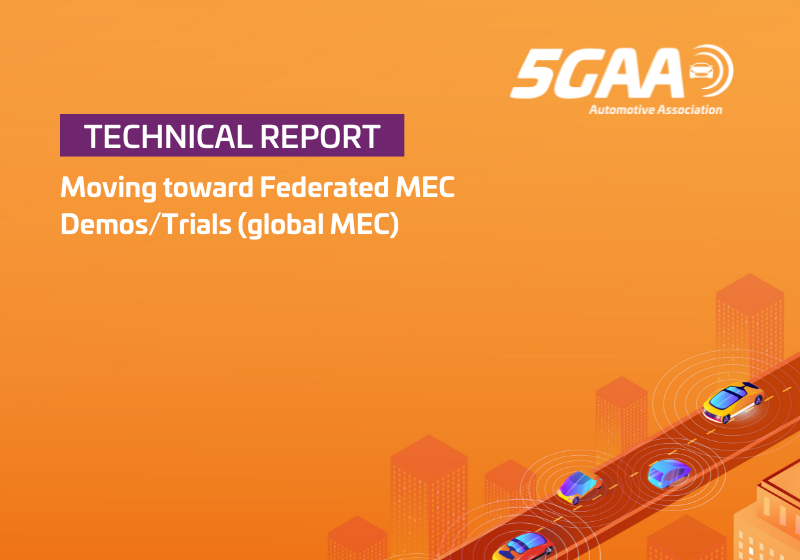
Moving toward Federated MEC Demos/Trials (global MEC)
This document is focusing on the MEC live trials and related public demonstrations of selected automotive use cases in multi-MNO multi-OEM environments, carried out in various regions of the world.
The report explores technical, regulatory and business constraints around deployment of multi-MNO MEC scenarios under different conditions and meeting auto OEM requirements
Read the report here.

Federal Funding Opportunity for Wireless Technology: Safe Streets and Roads for All (SS4A) Grant Program
Through September 15, 2022, a Notice of Funding Opportunity (NOFO) from the U.S. Department of Transportation (USDOT) will be open for Safe Streets and Roads for All (SS4A) grants in FY22. It’s an opportunity for companies to apply for a part of $1 billion per year in FY22-26 grants to prevent roadway deaths and serious injuries.
The timing is fortuitous. Newly released traffic crash estimates from the National Highway Traffic Safety Administration (NHTSA) show that traffic fatality rates in 2021 are the highest since 2005. NHTSA projects a final tally of 42,915 lives lost during 2021 in traffic crashes nationwide.
Making transportation safer and more equitable
To support its goals, the SS4A program funds activities that will help lower fatalities on U.S. roads and highways. The program is also an opportunity to fund regional, local and Tribal initiatives aimed at making transportation equitable for all road users.
Equity is an important element in underserved communities, which are disproportionately affected by fatalities among vulnerable road users (VRUs). These users include pedestrians, cyclists and the growing number people using micro-mobility options such as e-bikes and scooters.
Underserved communities also have higher vehicular traffic volumes, trucking routes and major arterial roads. They are characterized by intersections that are unsafe or impassable by foot or bike, and an overall lower level and quality of walking and cycling infrastructure. NHTSA’s projections for 2021 show alarming increases in fatalities for pedestrians (13 percent), motorcyclists (9 percent) and bicyclists (5 percent), making the SS4A funding opportunity even more fortuitous for VRUs.
Applying C-V2X technology to prevent road fatalities
Many roadway deaths are preventable. Cellular-vehicle-to-everything (C-V2X) is a wireless technology that allows vehicles to communicate directly with each other (V2V), with roadside infrastructure (V2I) and potentially with pedestrians (V2P). C-V2X supports information sharing to facilitate applications that enhance safety for all road users.
NHTSA believes that safety applications supported by V2V and V2I could eliminate or mitigate the severity of up to 80 percent of non-impaired crashes. Also, connected vehicle technology is on the National Transportation Safety Board’s Most Wanted List of transportation safety improvements.
The following use cases illustrate the immediate impact of safety applications that use C-V2X technology:
- Red-light violation warning (RLVW)
More than half of all fatal and injury crashes happen at intersections (source). The most common cause of all urban crashes, drivers running red lights result in an average of seven fatalities and more than 1,000 injuries per day at signalized intersections across the country (source).

- Intersection movement assist (IMA)
Similar to RLVW, IMA safety applications can alert other drivers when someone is running a red light so they can take action to stop before entering the intersection. - Spot weather warnings
Inclement weather, which can result in road hazards such as icy patches on highways, are not easily detected by LIDAR sensors. Infrastructure-to-vehicle (I2V) applications can send a warning to approaching vehicles, reducing the potential for sharp drops in speed that can result in road incidents. - Traffic signal pre-emption
Aimed at shortening emergency response times to help save lives, this use case allows vehicles like ambulances and fire trucks to remotely trigger a green light. Related V2V applications share this information with nearby vehicles so drivers can take action to move out of the way, reducing congestion along the route to improve safety for first responders and road users alike. - School zone safety
C-V2X alerts drivers when they are entering an active school zone and notifies them of the reduced speed limit. Future applications might include automatically slowing vehicles as they approach an active school zone.
See more use cases below.
What you can’t see can hurt you, and C-V2X plays a critical safety role because it allows the vehicle to see more than the driver can see. Regular sensors keep vehicles safe in immediate surroundings; C-V2X provides more robust signaling to help vehicles see around blind corners and many other types of obstructions. It connects vehicles and roadside infrastructure that are not in each other’s line of sight and allows them to share information about traffic conditions.
How C-V2X fits with SS4A
SS4A accepts both Action Plan Grants and Implementation Grants, with the latter drawing upon the foundation of the former. The program calls out four selection criteria:
- Safety impact
- Equity, engagement, collaboration
- Effective practices and strategies
- Climate and sustainability, and economic competitiveness
Two notable considerations are project readiness and funds to underserved communities.
USDOT lists several sample activities for Implementation Grants that align closely with C-V2X, including these:
- Deploying advanced transportation technologies, such as the installation of connected intersection-based safety solutions and vehicle-to-infrastructure advisory speed limit systems (e.g., intelligent speed assistance — see above)
- Evaluating and improving the safety of intersections by considering innovative design changes, improved delineation, and advanced warning
- Creating safe routes to school and public transit services through multiple activities that lead to people safely walking and biking in underserved communities.
- Promoting the adoption of innovative technologies or strategies for the safety and protection of VRUs in high-traffic areas where commercial motor vehicles (CMVs), pedestrians, bicyclists, and motorcyclists interact.
Next steps
As part of the Bipartisan Infrastructure Law, SS4A is a discretionary program with $5 billion in appropriated funds over the next 5 years. A related opportunity opening up in late 2022 is the $500 million Strengthening Mobility and Revolutionizing Transportation (SMART) Grants from USDOT. Both SS4A and SMART provide a path to federal funding to build novel uses of C-V2X and 5G technologies into the nation’s infrastructure. To provide more visibility for industry stakeholders, USDOT has published a full list of funding opportunities with anticipated dates for 2022.
Applications built around C-V2X can help make intersections safer and reduce fatalities due to speeding in the use cases shown above, as well as in these:
- At-grade rail crossings — alerting emergency vehicles that a rail crossing is closed, enabling early rerouting and avoiding delays in life-saving calls
- Pedestrian crossings — detecting when a VRU is in the crosswalk ahead and warning approaching drivers to proceed with caution
- Incident clearance and response — sending alerts to drivers as they approach an emergency vehicle stopped in or along the roadway ahead, thereby helping to prevent secondary crashes
- Wrong-way driving — detecting drivers who go the wrong way on on-ramps and highways, then alerting the driver, nearby drivers, and law enforcement
These applications can also help make transportation equitable in underserved communities, fulfilling another important goal of SS4A.
Find out how to apply for SS4A grants here and in the USDOT’s “Safe Streets and Roads for All” webinar series.

New Technical Report: Conformity Assessment Strategy Evaluation (CASE)
This 5GAA Technical Report presents the results of the 5GAA Work Item Conformity Assessment Strategy Evaluation (CASE). This study investigates a practical 5GAA strategy along with guidelines for Conformance Assessment (CA). The CASE Report focuses on the PC5 interface and intends to develop a proposal for a cost-effective, voluntary process for C-V2X Conformity Assessment which could be applied globally. In this document, you can read about the position of the Automotive Industry, the regional status of Conformity Assessment (China, Europe, North America, Japan and South Korea), lessons from other CA schemes, cost-benefit analysis, and a harmonised CA framework.
Read the full report.
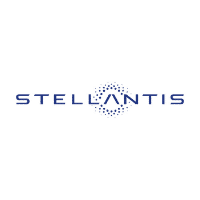
Stellantis – FCA (CRF) Italy S.p.A.
Stellantis is a leading global automaker and mobility provider that offers clean, connected, affordable and safe mobility solutions.

TNO (Nederlandse Organisatie voor Toegepast Natuurwetenschappelijk Onderzoek)
TNO connects people and knowledge to create innovations that boost the sustainable competitive strength of industry and well-being of society.
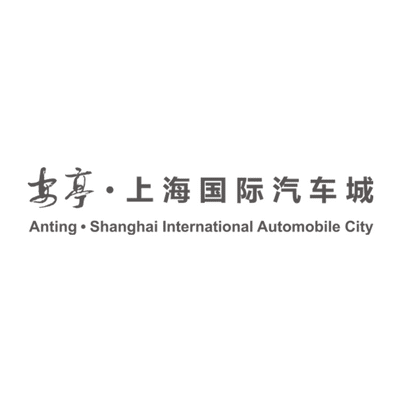
Shanghai International Automobile City (Group) Co., Ltd.
Shanghai International Automobile City is provides securities, commodity contracts industry financial investments, and related activities industry.


